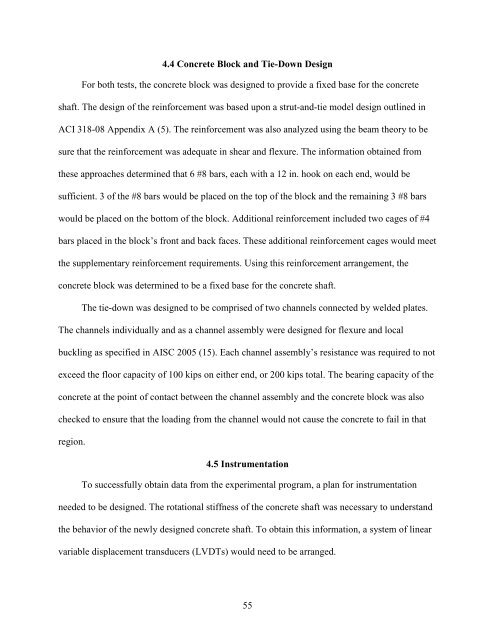Alternative Support Systems for Cantilever - National Transportation ...
Alternative Support Systems for Cantilever - National Transportation ...
Alternative Support Systems for Cantilever - National Transportation ...
You also want an ePaper? Increase the reach of your titles
YUMPU automatically turns print PDFs into web optimized ePapers that Google loves.
4.4 Concrete Block and Tie-Down Design<br />
For both tests, the concrete block was designed to provide a fixed base <strong>for</strong> the concrete<br />
shaft. The design of the rein<strong>for</strong>cement was based upon a strut-and-tie model design outlined in<br />
ACI 318-08 Appendix A (5). The rein<strong>for</strong>cement was also analyzed using the beam theory to be<br />
sure that the rein<strong>for</strong>cement was adequate in shear and flexure. The in<strong>for</strong>mation obtained from<br />
these approaches determined that 6 #8 bars, each with a 12 in. hook on each end, would be<br />
sufficient. 3 of the #8 bars would be placed on the top of the block and the remaining 3 #8 bars<br />
would be placed on the bottom of the block. Additional rein<strong>for</strong>cement included two cages of #4<br />
bars placed in the block’s front and back faces. These additional rein<strong>for</strong>cement cages would meet<br />
the supplementary rein<strong>for</strong>cement requirements. Using this rein<strong>for</strong>cement arrangement, the<br />
concrete block was determined to be a fixed base <strong>for</strong> the concrete shaft.<br />
The tie-down was designed to be comprised of two channels connected by welded plates.<br />
The channels individually and as a channel assembly were designed <strong>for</strong> flexure and local<br />
buckling as specified in AISC 2005 (15). Each channel assembly’s resistance was required to not<br />
exceed the floor capacity of 100 kips on either end, or 200 kips total. The bearing capacity of the<br />
concrete at the point of contact between the channel assembly and the concrete block was also<br />
checked to ensure that the loading from the channel would not cause the concrete to fail in that<br />
region.<br />
4.5 Instrumentation<br />
To successfully obtain data from the experimental program, a plan <strong>for</strong> instrumentation<br />
needed to be designed. The rotational stiffness of the concrete shaft was necessary to understand<br />
the behavior of the newly designed concrete shaft. To obtain this in<strong>for</strong>mation, a system of linear<br />
variable displacement transducers (LVDTs) would need to be arranged.<br />
55
















